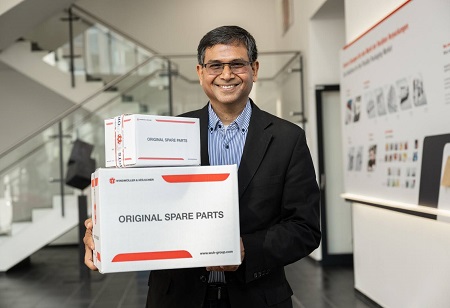
In an interaction with Industry Outlook, Prakash shares his views on the recent trends and innovations shaping machinery manufacturing in Africa, the Middle East, and India, how companies are adopting Industry 4.0 technologies to enhance productivity and efficiency, and more.
Holding an MBA in Business Administration & General Management from Hochschule Bielefeld, Prakash has been associated with W&H Group for over 36 years now and has successfully handled key roles across diverse capacities.
Tell us about a few recent trends and innovations shaping machinery manufacturing in Africa, the Middle East, and India.
These markets are expected to offer healthy growth in the near future. The flexible packaging market helps to meet existential needs in most of these regions and must be produced most cost-effectively. Sustainable packaging is another factor that has gained a lot of traction lately in these regions, wherein automation and digital solutions are playing a major role in this development.
How are companies adopting Industry 4.0 technologies to enhance productivity and efficiency?
Often referred to as the Fourth Industrial Revolution, Industry 4.0 encompasses a range of innovative technologies and practices that transform how products are designed, produced, and delivered. Industry 4.0 technologies have enabled businesses to enhance productivity and efficiency by integrating digital technologies, data, and automation into their manufacturing processes. Companies can collect real-time complex data through various sensors & algorithms and store it in a user-friendly manner. This data helps monitor performance, identify maintenance needs, and optimize production processes. Also, smart factories that comprise automated machines and digitalized processes are enabling companies to perform tasks with precision and speed, along with minimum human intervention. Additionally, AR/VR technologies are being employed for training, maintenance, and remote assistance, wherein workers can use AR headsets to access information and instructions in real time while performing tasks.
Throw some light on the growth and investment opportunities in these regions.
With developing economies in these regions seeing a lot of scope for an increase in consumption, the growth and opportunities will continue. People understand the importance of packaging, and the same is evident in their buying behavior. There are some sustainability-related concerns, and we strongly believe that the way forward is not around flexible packaging but through it. Currently, we are in a transition phase, where on one side conventional products are evolving to meet current requirements, and on the other side, new products are being introduced into the markets. We see good growth in sustainable single-family laminates with the use of enhanced substrates like CPP or MDO PE along with new rotogravure printing technologies. Coatings and lacquer to infuse barrier properties, heat resistance, and enhanced optical properties will be growing as well.
What does the future hold for the packaging industry specifically in India?
In India, the packing of polymer bags is slowly shifting from woven bags to PE bags, whereas newer woven bag closure techniques are available for increased productivity in the segment. Paper bags are making their way to larger product portfolios, offering more variety and diversification verticals for the industry. We always evaluate the investment potential based on the demands of the local market and their propensity to accept the required solutions. Cost factors like the availability of raw materials, manpower, and supply chain bottlenecks must be evaluated by customers before investing in any new technology or product.
We use cookies to ensure you get the best experience on our website. Read more...